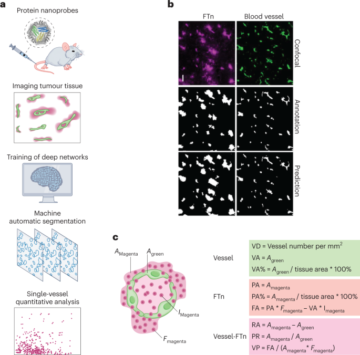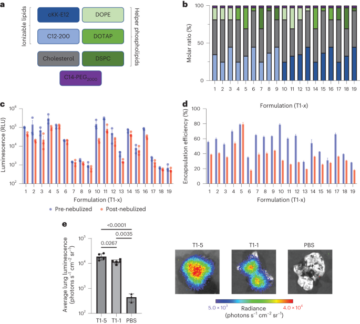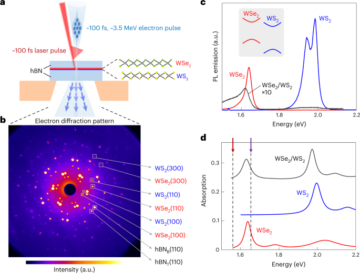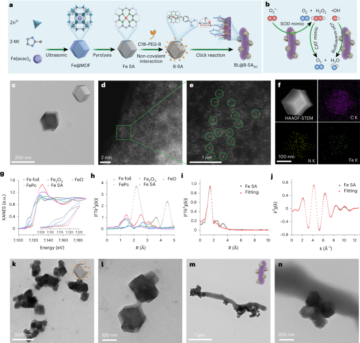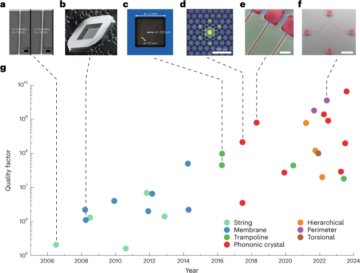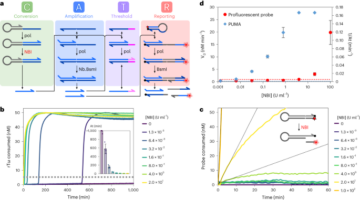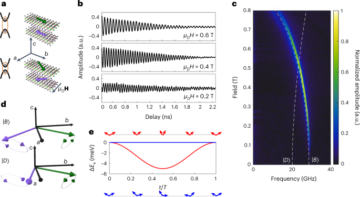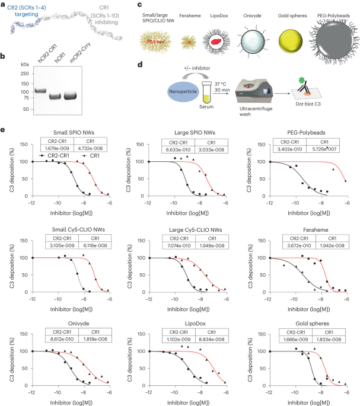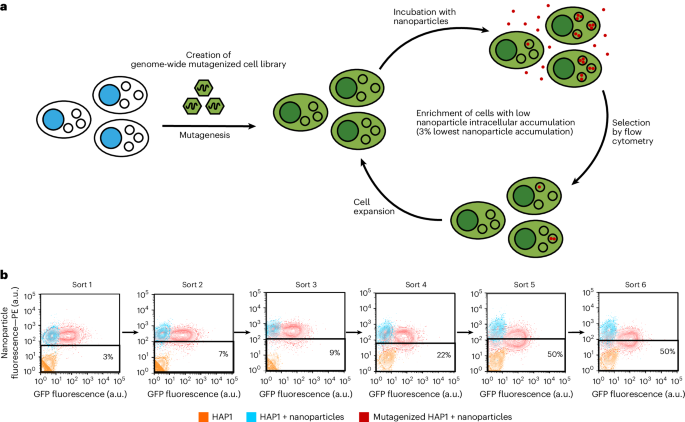
Blanco, E., Shen, H. & Ferrari, M. Principles of nanoparticle design for overcoming biological barriers to drug delivery. Nat. Biotechnol. 33, 941–951 (2015).
Chou, L. Y. T., Ming, K. & Chan, W. C. W. Strategies for the intracellular delivery of nanoparticles. Chem. Soc. Rev. 40, 233–245 (2011).
Duncan, R. & Richardson, S. C. W. Endocytosis and intracellular trafficking as gateways for nanomedicine delivery: opportunities and challenges. Mol. Pharm. 9, 2380–2402 (2012).
Iversen, T.-G., Skotland, T. & Sandvig, K. Endocytosis and intracellular transport of nanoparticles: present knowledge and need for future studies. Nano Today 6, 176–185 (2011).
Rennick, J. J., Johnston, A. P. R. & Parton, R. G. Key principles and methods for studying the endocytosis of biological and nanoparticle therapeutics. Nat. Nanotechnol. 16, 266–276 (2021).
Francia, V. et al. Corona composition can affect the mechanisms cells use to internalize nanoparticles. ACS Nano 13, 11107–11121 (2019).
Iversen, T. G., Frerker, N. & Sandvig, K. Uptake of ricinB-quantum dot nanoparticles by a macropinocytosis-like mechanism. J. Nanobiotechnol. 10, 33 (2012).
Sharma, S., Bartholdson, S. J., Couch, A. C. M., Yusa, K. & Wright, G. J. Genome-scale identification of cellular pathways required for cell surface recognition. Genome Res. 28, 1372–1382 (2018).
Collinet, C. et al. Systems survey of endocytosis by multiparametric image analysis. Nature 464, 243–249 (2010).
Carette, J. E. et al. Haploid genetic screens in human cells identify host factors used by pathogens. Science 326, 1231–1235 (2009).
Navarro Negredo, P. et al. Contribution of the clathrin adaptor AP-1 subunit µ1 to acidic cluster protein sorting. J. Cell Biol. 216, 2927–2943 (2017).
Jae, L. T. et al. Deciphering the glycosylome of dystroglycanopathies using haploid screens for lassa virus entry. Science 340, 479–483 (2013).
Duncan, L. M. et al. Fluorescence-based phenotypic selection allows forward genetic screens in haploid human cells. PLoS ONE 7, e39651 (2012).
Davis, E. M. et al. Comparative haploid genetic screens reveal divergent pathways in the biogenesis and trafficking of glycophosphatidylinositol-anchored proteins. Cell Rep. 11, 1727–1736 (2015).
Luteijn, R. D. et al. A genome-wide haploid genetic screen identifies heparan sulfate-associated genes and the macropinocytosis modulator TMED10 as factors supporting vaccinia virus infection. J. Virol. 93, e02160-18 (2019).
Carette, J. E. et al. Ebola virus entry requires the cholesterol transporter Niemann–Pick C1. Nature 477, 340–343 (2011).
Ngo, W. et al. Identifying cell receptors for the nanoparticle protein corona using genome screens. Nat. Chem. Biol. 18, 1023–1031 (2022).
Riblett, A. M. et al. A haploid genetic screen identifies heparan sulfate proteoglycans supporting Rift Valley fever virus infection. J. Virol. 90, 1414–1423 (2016).
Pillay, S. et al. An essential receptor for adeno-associated virus infection. Nature 530, 108–112 (2016).
Lara, S. et al. Identification of receptor binding to the biomolecular corona of nanoparticles. ACS Nano 11, 1884–1893 (2017).
Akinc, A. et al. The Onpattro story and the clinical translation of nanomedicines containing nucleic acid-based drugs. Nat. Nanotechnol. 14, 1084–1087 (2019).
Liu, K. et al. Multiomics analysis of naturally efficacious lipid nanoparticle coronas reveals high-density lipoprotein is necessary for their function. Nat. Commun. 14, 4007 (2023).
Rees, P., Wills, J. W., Brown, M. R., Barnes, C. M. & Summers, H. D. The origin of heterogeneous nanoparticle uptake by cells. Nat. Commun. 10, 2341 (2019).
Panet, E. et al. The interface of nanoparticles with proliferating mammalian cells. Nat. Nanotechnol. 12, 598–600 (2017).
Åberg, C., Piattelli, V., Montizaan, D. & Salvati, A. Sources of variability in nanoparticle uptake by cells. Nanoscale 13, 17530–17546 (2021).
Christianson, H. C., Svensson, K. J., van Kuppevelt, T. H., Li, J. P. & Belting, M. Cancer cell exosomes depend on cell-surface heparan sulfate proteoglycans for their internalization and functional activity. Proc. Natl Acad. Sci. USA 110, 17380–17385 (2013).
Joshi, B. S. & Zuhorn, I. S. Heparan sulfate proteoglycan-mediated dynamin-dependent transport of neural stem cell exosomes in an in vitro blood–brain barrier model. Eur. J. Neurosci. 53, 706–719 (2021).
Panarella, A. et al. A systematic high-content screening microscopy approach reveals key roles for Rab33b, OATL1 and Myo6 in nanoparticle trafficking in HeLa cells. Sci. Rep. 6, 28865 (2016).
Hofmann, D. et al. Mass spectrometry and imaging analysis of nanoparticle-containing vesicles provide a mechanistic insight into cellular trafficking. ACS Nano 8, 10077–10088 (2014).
Shapero, K. et al. Time and space resolved uptake study of silica nanoparticles by human cells. Mol. BioSyst. 7, 371–378 (2011).
Turnbull, J., Powell, A. & Guimond, S. Heparan sulfate: decoding a dynamic multifunctional cell regulator. Trends Cell Biol. 11, 75–82 (2001).
Martinez, P. et al. Macrophage polarization alters the expression and sulfation pattern of glycosaminoglycans. Glycobiology 25, 502–513 (2015).
Thomas, M. & Klibanov, A. M. Non-viral gene therapy: polycation-mediated DNA delivery. Appl. Microbiol. Biotechnol. 62, 27–34 (2003).
Favretto, M. E., Wallbrecher, R., Schmidt, S., van de Putte, R. & Brock, R. Glycosaminoglycans in the cellular uptake of drug delivery vectors—bystanders or active players? J. Control. Release 180, 81–90 (2014).
Olivieri, P. H., Jesus, M. B., Nader, H. B., Justo, G. Z. & Sousa, A. A. Cell-surface glycosaminoglycans regulate the cellular uptake of charged polystyrene nanoparticles. Nanoscale 14, 7350–7363 (2022).
Christianson, H. C. & Belting, M. Heparan sulfate proteoglycan as a cell-surface endocytosis receptor. Matrix Biol. 35, 51–55 (2014).
Zhang, Q. et al. Heparan sulfate assists SARS-CoV-2 in cell entry and can be targeted by approved drugs in vitro. Cell Discov. 6, 80 (2020).
Stanford, K. I. et al. Syndecan-1 is the primary heparan sulfate proteoglycan mediating hepatic clearance of triglyceride-rich lipoproteins in mice. J. Clin. Invest. 119, 3236–3245 (2009).
Williams, K. J. & Fuki, I. V. Cell-surface heparan sulfate proteoglycans: dynamic molecules mediating ligand catabolism. Curr. Opin. Lipidol. 8, 253–262 (1997).
Shen, W. J., Asthana, S., Kraemer, F. B. & Azhar, S. Scavenger receptor B type 1: expression, molecular regulation, and cholesterol transport function. J. Lipid Res. 59, 1114–1131 (2018).
Kolset, S. O. & Salmivirta, M. Cell surface heparan sulfate proteoglycans and lipoprotein metabolism. Cell. Mol. Life Sci. 56, 857–870 (1999).
Lesniak, A. et al. Nanoparticle adhesion to the cell membrane and its effect on nanoparticle uptake efficiency. J. Am. Chem. Soc. 135, 1438–1444 (2013).
Yang, K., Mesquita, B., Horvatovich, P. & Salvati, A. Tuning liposome composition to modulate corona formation in human serum and cellular uptake. Acta Biomater. 106, 314–327 (2020).
Dilliard, S. A., Cheng, Q. & Siegwart, D. J. On the mechanism of tissue-specific mRNA delivery by selective organ targeting nanoparticles. Proc. Natl Acad. Sci. USA 118, e2109256118 (2021).
Cheng, Q. et al. Selective organ targeting (SORT) nanoparticles for tissue-specific mRNA delivery and CRISPR–Cas gene editing. Nat. Nanotechnol. 15, 313–320 (2020).
Ritz, S. et al. Protein corona of nanoparticles: distinct proteins regulate the cellular uptake. Biomacromolecules 16, 1311–1321 (2015).
Jones, A. L., Hulett, M. D. & Parish, C. R. Histidine-rich glycoprotein binds to cell-surface heparan sulfate via its N-terminal domain following Zn2+ chelation. J. Biol. Chem. 279, 30114–30122 (2004).
- SEO Powered Content & PR Distribution. Get Amplified Today.
- PlatoData.Network Vertical Generative Ai. Empower Yourself. Access Here.
- PlatoAiStream. Web3 Intelligence. Knowledge Amplified. Access Here.
- PlatoESG. Carbon, CleanTech, Energy, Environment, Solar, Waste Management. Access Here.
- PlatoHealth. Biotech and Clinical Trials Intelligence. Access Here.
- Source: https://www.nature.com/articles/s41565-024-01629-x
- :is
- ][p
- 00
- 003
- 02
- 05
- 1
- 10
- 11
- 12
- 125
- 13
- 14
- 15%
- 16
- 17
- 19
- 1999
- 2%
- 20
- 2001
- 2009
- 2010
- 2011
- 2012
- 2013
- 2014
- 2015
- 2016
- 2017
- 2018
- 2019
- 2020
- 2021
- 2022
- 2023
- 21
- 22
- 23
- 24
- 25
- 26
- 27
- 28
- 29
- 30
- 31
- 32
- 33
- 34
- 35%
- 36
- 39
- 4
- 40
- 41
- 42
- 45
- 46
- 5
- 6
- 7
- 8
- 80
- 9
- a
- active
- activity
- Ads
- affect
- AL
- allows
- am
- an
- analysis
- and
- approach
- approved
- article
- AS
- assists
- b
- barrier
- barriers
- BE
- binding
- brock
- brown
- by
- CAN
- Cancer
- cell
- Cells
- cellular
- central
- challenges
- chan
- charged
- Cheng
- clearance
- click
- Clinical
- Cluster
- composition
- containing
- contribution
- control
- Corona
- de
- Decoding
- delivery
- depend
- Design
- distinct
- dna
- domain
- DOT
- drug
- Drug Delivery
- Drugs
- dynamic
- e
- E&T
- Ebola
- effect
- efficiency
- entry
- essential
- Ether (ETH)
- expression
- factors
- Ferrari
- Fever
- following
- For
- formation
- Forward
- function
- functional
- future
- gateways
- gene editing
- genetic
- genome
- harvard
- host
- http
- HTTPS
- human
- i
- Identification
- identifies
- identify
- identifying
- image
- image analysis
- Imaging
- in
- infection
- insight
- Interface
- into
- Invest
- ITS
- Key
- knowledge
- li
- Life
- LINK
- Mass
- mechanism
- mechanisms
- methods
- mice
- Microscopy
- model
- MOL
- molecular
- mRNA
- Nanomedicine
- nanotechnology
- naturally
- Nature
- necessary
- Need
- Neural
- NIH
- of
- on
- opportunities
- or
- Origin
- overcoming
- pathways
- Pattern
- plato
- Plato Data Intelligence
- PlatoData
- players
- Powell
- present
- primary
- principles
- processing
- Protein
- Proteins
- provide
- R
- receptor
- recognition
- reference
- Regulate
- Regulation
- regulator
- required
- requires
- resolved
- reveal
- Reveals
- rift
- roles
- s
- SARS-CoV-2
- Scholar
- SCI
- Screen
- screening
- screens
- selection
- selective
- Serum
- sort
- Sources
- Space
- Stem
- Story
- strategies
- studies
- Study
- Studying
- Supporting
- Surface
- Survey
- Systems
- T
- targeted
- targeting
- The
- their
- therapeutics
- therapy
- time
- to
- trafficking
- Translation
- transport
- tuning
- type
- uptake
- use
- used
- using
- Valley
- van
- via
- virus
- W
- with
- Wright
- zephyrnet


